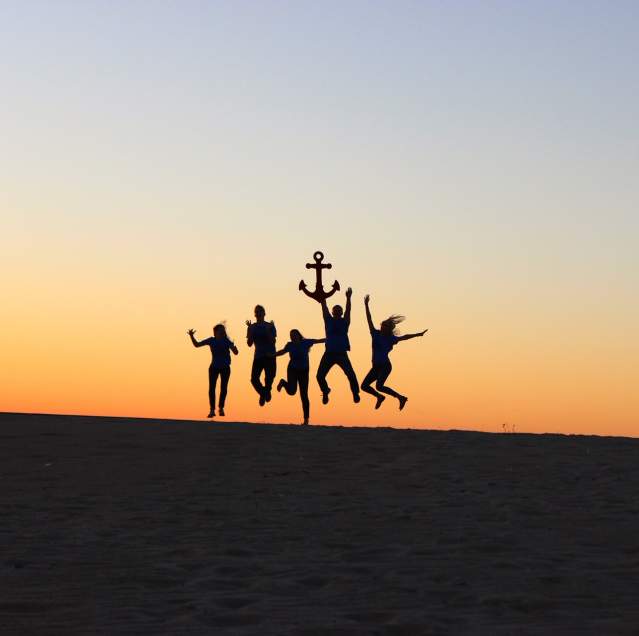WMTA’S History
West Michigan Tourist Association: Promoting MI since 1917
WMTA has a long and proud history of supporting and promoting tourism in West Michigan. The below article details the creation and history of WMTA under the direction of Hugh J. Gray.
Hugh J. Gray, “Dean of Michigan’s Tourist Activity”
by. M. Christine Byron
Michigan today is known as a vacationer’s paradise, blessed with a wealth of natural beauty, recreational opportunities and pleasant accommodations, but it wasn’t always that way. At the turn of the 20th century, the great lumber era had left the state with vast cutover lands with few agricultural prospects. The thousands of lakes and streams awaited development of their recreational potential, and the resort business was in its infancy.
Although the various steamship and railroad lines, hotels and resorts promoted the areas that they served, there was no organized body promoting the entire state. Little cooperation existed among communities, and small rivalries and petty jealousies prevailed among resort operators. With the Good Roads movement taking hold, automobiles were becoming affordable for the average family and more people were taking vacations, but many of the resort accommodations were poor, and no special efforts were made to provide for the comfort and enjoyment of visitors.
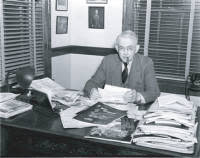
Shown here at his desk in the West Michigan Tourist and Resort Association office in Fulton Park, Hugh J. Gray served the organization for 26 years. (Grand Rapids Public Library, Robinson Photographic Studio Collection)
One early attempt to place the issue before the public eye was a series of articles about the Colorado tourist industry written by Arthur W. Stace, a young reporter for the Grand Rapids Press and later its managing editor. The newspaper had sent Stace to Colorado in October 1916 to find out how the state, which had gone “dry” earlier than the rest of the country, was handling the “prohibition problem.” Stace came back more excited about Colorado’s tourist business than its lack of alcohol. He wrote three articles on Colorado’s tourist association, which was formed when Denver businessmen feared Prohibition would give the tourist business an “awful bump.” The association tried to stimulate tourist travel to Colorado and to combine the interests of various tourist-serving groups in a cooperative endeavor. Through a broad advertising campaign, the association had lured nearly 300,000 tourists into Colorado and was beginning to advertise in the Midwest.
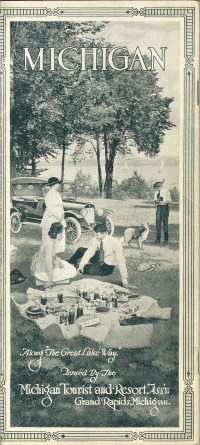 Stace feared that Colorado would capture the lucrative tourist business coming out of Chicago, St. Louis and other markets. He advocated forming a central organization that would promote the tourist advantages of Michigan and encourage more comfortable accommodations, better highways and improved transportation. Stace’s work bore fruit a few months later when the Western Michigan Development Bureau and the Association of Commerce of Grand Rapids sent out letters to city and county governments, as well as to several hundred hotel and resort operators, retailers, bankers, real estate dealers and other businessmen, calling for a meeting to promote Michigan throughout the rest of the country.
Stace feared that Colorado would capture the lucrative tourist business coming out of Chicago, St. Louis and other markets. He advocated forming a central organization that would promote the tourist advantages of Michigan and encourage more comfortable accommodations, better highways and improved transportation. Stace’s work bore fruit a few months later when the Western Michigan Development Bureau and the Association of Commerce of Grand Rapids sent out letters to city and county governments, as well as to several hundred hotel and resort operators, retailers, bankers, real estate dealers and other businessmen, calling for a meeting to promote Michigan throughout the rest of the country.
Seventy-five delegates representing every county in western Michigan came together on May 7, 1917, at the Pantlind Hotel in Grand Rapids. The result of that initial meeting was the formation of the Michigan Tourist and Resort Association (MTRA), later called the West Michigan Tourist Association. Modeled after Colorado’s tourist association and similar business groups in San Antonio, Texas, and Hot Springs, Arkansas, the new association was to be incorporated under the laws of Michigan as a nonprofit corporation whose purpose was “to make known to travelers everywhere the attractions of Michigan; to furnish them with complete and accurate information; to promote tourist travel and to develop among our own people an appreciation of the importance of the tourist business as a factor in our commercial success and social development. The first slate of officers chosen to head the new association were President J.H.P. Hughart, president of the Grand Rapids & Indiana Railway; First Vice President David H. Day, of Glen Haven; and Treasurer Carroll F. Sweet of Grand Rapids. The executive committee, drawn from a number of West Michigan locales, was made up of George H. Van Pelt of Charlevoix; William H. Loutit of Grand Haven; L.F. Bertrau of Big Rapids; E.R. Swett of Muskegon; R.H. Sherwood of Watervliet; and A.B. Klise of Petoskey. It was decided that dues would be $25 per year per member and that each member would be asked to sign up for three years.

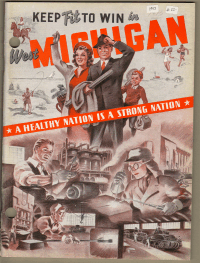
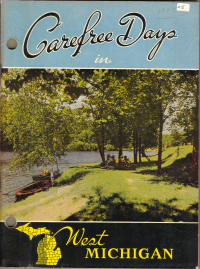

As one of its first orders of business, the group secured the services of Hugh J. Gray, who was to be given the title of secretary/manager and paid a salary of $300 per month plus expenses. Responsible for recruiting new members, creating advertisements and promotions, and the day-to-day running of the organization, the secretary/manager was the person who really ran the show. With an established career and a quarter-century of experience in railroading behind him, Hugh Gray was the right man for the job. He would remain at his post for the next 26 years, energetically coordinating the efforts of business leaders, transportation companies, hotels and resorts, in order not only to attract visitors to Michigan, but also to make their stays enjoyable.
Born in 1868 in Lakeville, Michigan, Gray was obliged to become a breadwinner at the age of 13 when his father died. At 17 he came to Grand Rapids to take a job as a car sealer for the Grand Rapids & Indiana Railway. Steady advancement carried him five years later to a position as a rate clerk in the passenger department of the Chicago & West Michigan Railroad. Gray often commented that this job placing him in charge of promotional booklets and advertising, many of which were designed to lure travelers to western Michigan, actually started him on his career in the
tourist business.
In 1900 the Chicago & West Michigan Railroad merged with the Père Marquette Railroad, and Gray was named city passenger agent in Grand Rapids. His next promotion was to division passenger agent for the entire western half of Michigan from the Indiana border to Mackinaw City. In 1911 he was transferred to Chicago and promoted to general western passenger agent, in charge of all territories south and west of Chicago. During his tenure as a Père Marquette Railroad agent, Gray was appointed to the executive board of the Western Michigan Development Bureau.
After Gray cast his lot with the newly formed Michigan Tourist and Resort Association, he worked out of a 10′ x 12′ loft office in Grand Rapids, with only the help of a stenographer. He bought his first automobile, a Velie, and started driving all over the sand trails of western Michigan, interviewing businessmen and enlisting members. Appeals were made to resort owners, hotel operators, garage managers, wholesalers, retailers, public utilities, chambers of commerce and civic organizations throughout western Michigan to become members of the new organization. During his first year with the MTRA, he put 8,000 hard, dusty miles on his car and raised about $4,000 for advertising and promotion. Gray conducted a survey to gather information on every resort, its capacity, amusements offered, driving directions and other salient facts. The association worked closely with the steamship and railroad companies to attract visitors to Michigan. These transportation lines included Northern Michigan Transportation, Graham and Morton, and Goodrich Steamship Lines as well as Michigan Central, Père Marquette and Pennsylvania railroads.
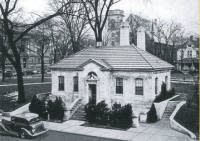
The West Michigan Tourist and Resort Association moved into this charming building still standing at 22 Sheldon NE in Fulton (now Veteran’s Memorial) Park in 1936. (Carefree Days in West Michigan, 1939
Within a short time, the retail merchants of Grand Rapids recognized the value of Gray’s efforts and, in 1919, agreed to take on the MTRA’s rent and overhead expenses for one year. Because the association believed that better results could be obtained when the office was located on the street, not up in an office building, they installed an information bureau in the Morton House lobby. There, tourist information on various resorts and attractions throughout the state was available to visitors. A stereopticon machine ran from 8 p.m. until 11 p.m. showcasing scenes of Michigan’s attractions. In 1921 a tourist information booth was set up in downtown Grand Rapids in Campau Square, replacing the Morton House bureau. The booth proved so successful that the City of Grand Rapids took over its operation the following year and served over 12,000 visitors. As membership in the MTRA grew, membership dues provided the finances for operating expenses and the association moved to 96 Monroe Avenue in the Aldrich Building. As a further means of attracting tourists to West Michigan, Gray created a “scientific publicity campaign” with advertisements in 90 midwestern and southern newspapers. Concentrated on an area that encompassed Cleveland, Cincinnati, St. Louis, Kansas City, Omaha and Chicago, the advertisements paid off royally, attracting an estimated 80 to 90 percent of all vacationers to Michigan in the association’s early years. The MTRA later advertised in national magazines such as Colliers, the Saturday Evening Post and Life.
Under Hugh Gray’s leadership, an annual guide, the West Michigan Vacation Directory, made its debut in the early 1920s and by 1927 included three-color maps that showed main highways as well as railroad and interurban lines, lakes and rivers. Also included were listings of hotels, state parks, campgrounds, golf courses, hunting and fishing regulations and traffic rules. Resort experts considered the directory to be one of the finest published anyplace in the United States. By 1936 the vacation directory had evolved into Carefree Days in West Michigan and continues today as West Michigan Carefree Travel Guide. Over the years the MTRA also went on to publish fishing, hunting and canoeing guides, to distribute seasonal booklets promoting fall color tours and winter sports and to recommend road signs to help motorists find their way.
Gray also arranged for the state highway commission to furnish the association with weekly bulletins regarding road conditions, detours and other travel information to be passed on to its members and inquiring travelers. He urged the state health department to have its traveling laboratories monitor sanitary conditions, clean water, good milk and food at hotels, resorts, restaurants and public bathing beaches. Gray encouraged the state police to handle visiting motorists with courtesy and helpful directions. He worked closely with the department of agriculture, which supervised hotels and resorts, and also with conservation officials in improving access to the state’s natural resources, especially those related to hunting and fishing. All of these efforts contributed to people feeling safe and secure and wanting to return to Michigan for another memorable vacation.
Much of Gray’s successful boosterism had ripple effects. In the 1920s and 1930s many lakeshore counties saw their resort properties double thanks to the construction of family cottages and resort facilities. Almost every county in West Michigan saw an increase in its property tax revenues from vacation homes. Retail sales soared during the summer months, bringing a new prosperity to many small towns whose merchants were only too happy to supply the vacation essentials such as fishing tackle, bathing suits, cameras and compasses, which, according to a 1927 survey, many forgetful tourists were apt to leave at home. With the additional purchases of regular supplies of food and gasoline, stores and restaurants catering to the traveling public saw increased profits. Members of the Michigan Resort and Tourist Association were listed in the booklets that the organization published and were also allowed to have their own promotional booklets on display at the various information offices that the organization maintained. The association supplied them with signs they could display on their premises announcing their MRTA membership, and they were sent “up-to-the-minute” bulletins listing the inquiries received by the association. Each person making an inquiry received a relevant publication and a personal letter from Gray or one of his associates with the MTRA.
Gray’s work in western Michigan was quickly copied in other sections of the state and three other organizations were formed to promote their particular regions. Gray worked closely with the Upper Peninsula Development Bureau, the Eastern Michigan Tourist and Resort Association and the Southeastern Michigan Tourist and Publicity Bureau to develop promotional campaigns. In 1929, Gray led the movement to secure the first state appropriations for tourist advertising. He promoted the immense value of the tourist industry to the State Legislature and secured $100,000 for advertising per year for two years, to be divided equally among the four regional associations and matched by each of them. When state politicians attempted to convert tourist promotion to a state operation rather than keeping it a private venture, Gray fought back. Despite the generous government appropriations granted for its support, Gray sought to maintain private enterprise as the moving force of the tourist trade in Michigan.
Yielding to the efforts of Gray and other tourist leaders to keep the state from moving in to control tourism, the Legislature created the Michigan Tourist and Resort Commission in 1934 to serve as a nonpartisan buffer between the state and the regional tourist organizations. Gray was appointed to head the commission in its first year. It was at this point that the Michigan Tourist and Resort Association changed its name to the West Michigan Tourist and Resort Association (WMTRA). In 1961, the name was further shortened to West Michigan Tourist Association. In the early days Gray fought strong efforts to turn the association into a promotional group for real estate enterprises. Efforts were also launched to turn the association into a trade group strictly designed to serve the individual needs of the resort operators. Gray succeeded in fending off these dissenters and preserving the original purpose of the organization: to bring more visitors to Michigan.
Gray originated the idea of maintaining out-of-state offices in populous centers to help direct the tourist flow into Michigan. The first such office was established in Chicago in 1929 and proved immediately successful. Within the initial three months, 5,500 persons visited the office and several thousand others asked for information about Michigan. By 1932 the Chicago center moved to North Michigan Avenue and sported a 16-foot-wide neon sign that said “Michigan – Playground of the Nation.”
Other offices were eventually established in Detroit, Cincinnati, Cleveland and St. Louis. The WMTRA also distributed its publications through other travel information centers in Illinois, Indiana, Iowa, Kansas, Missouri, Nebraska, Ohio, Oklahoma and Wisconsin. In addition, the Greyhound Bus Lines distributed the association’s materials to its passengers. The association was also active locally. It worked closely with the Grand Rapids Association of Commerce in staffing tourist information booths at three points on main highways entering the city. Tourist brochures and maps were supplied to visitors. Gray “was devoted to the promotion of local enthusiasm for tourist development and stressed the value of that industry to Grand Rapids.” 2
He estimated that approximately one-third of the money annually brought into Michigan by tourists and resorters found its way into, or back into, the coffers of the people of Grand Rapids, who serviced most of western Michigan through their wholesale, retail and service establishments. Gray also came up with the idea of an annual four-day, conducted tour for newspapermen and publicists to give them first-hand experience of some of West Michigan’s hotels, scenic spots and tourist attractions. At each stop along the way, local officials or businessmen led the journalists on guided tours and wined and dined them at local hotels or eateries. Besides impressing the visitors with the beauty of the resort regions, the excellent highway conditions and the bounty of available fishing, boating and recreational facilities, the tour resulted in much goodwill, which created hundreds of thousands of words of free publicity for Michigan’s attractions. The idea was so successful that other states soon copied it.
Gray and the association played a leading part in the promotion and development of the state park system. He anticipated the motor-camping craze of the 1920s and recommended that the state parks provide camping facilities for the convenience of motorists. He encouraged the state park system to supply maps indicating available facilities for campers, including amenities such as fresh water, firewood and comfort stations. Gray was also a leading proponent for the establishment of the Manistee National Forest. The forest was first proposed unsuccessfully by E.W. Tinker to President Herbert Hoover. Tinker was the regional forester in charge of the Great Lakes region. When President Franklin Roosevelt appeared favorable to such projects, Tinker again proposed a national forest in the Manistee area. The MTRA supported the proposal, enlisted the enthusiastic assistance of chambers of commerce throughout western Michigan and in four days flooded Washington with information and promotional material from the entire region. In August of 1933 the National Forest Reservation Commission approved the creation of the new forest. Land was acquired over the next five years and the Manistee National Forest was formally dedicated in 1938. Forestry leaders admitted “that had it not been for the tireless efforts of Mr. Gray,” the project would not have been accomplished in such an expedient manner.
Hugh Gray knew that vacationers wanted activities and entertainment. He persuaded resort operators to provide year-round amusements for their guests and to promote such local attractions as fishing, canoeing and horseback riding. He encouraged the creation of local festivals and was actively involved in the development of winter sports. He also saw to it that the association’s annual publications listed festivals, pageants, tournaments and regattas.Gray saw the value in a wide variety of promotions. The association sponsored half-hour travelogues on Chicago’s WMAQ and WGN radio stations, each one introduced with Irving Berlin’s song, I Want to Go Back to Michigan. WKZO in Kalamazoo and WJR in Detroit likewise broadcast travelogues for the association. Gray also used motion pictures and lectures to help advertise West Michigan’s attractions. The association ran a series of publicity lectures during the winter in Florida, promoting Michigan’s cool summers. Under Gray’s guidance, the association participated in the Detroit Outdoor Life Show, the Chicago Outdoor Show, the Izaak Walton League Show in Chicago and other shows and conferences that had potential for drawing visitors to vacation in Michigan.
In an effort to professionalize the industry, Gray promoted the establishment of short courses in hotel management at Michigan State College (now University), which in later years grew into a full academic program. In 1941 Gray sent his field secretary to officiate as the traveling instructor for “tourist information” classes, which were offered by the State Board of Control for Vocational Education, Michigan State College and the West Michigan Tourist and Resort Association. Classes gave “scientific sales instruction” to persons interested in answering inquiries of tourists, motorists or other travelers. Class attendees included people from hotels, restaurants, gas stations, taxicab companies, railroad companies and bus lines. Under Hugh Gray’s guidance and thanks to his untiring enthusiasm, the West Michigan tourist industry grew bit by bit, then by leaps and bounds, becoming the second largest industry in the state. Working ceaselessly through the early years to overcome the jealousies among the various resorts, Gray was admired for his sense of fairness. He knew that “there was enough business for everybody if we just work together to boost Michigan as a whole,” and he firmly believed that what benefited the state as a whole would benefit the tourist industry.
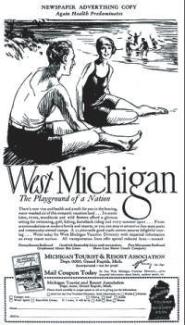
Hugh Gray placed ads such as this promotion of Michigan as the “Playground of a Nation” in daily newspapers throughout the Midwest. (Archives of Michigan, West Michigan Tourist Association Collection)

Publications like this map promoted Grand Rapids as the “Gateway to the Playground of a Nation.” (Grand Rapids Public LIbrary Ephemera Collection)
Gray was widely known and respected throughout the state. Very rare is the man who has seen a monument dedicated to his accomplishments in his lifetime, but Gray enjoyed that honor on June 28, 1938, when the Hugh J. Gray Cairn was officially dedicated. More than 1,000 people attended the dedication ceremonies, and traffic had to be rerouted around the site. Speakers from all over the state paid tribute to Hugh Gray that day, including representatives from the governor’s office, the state highway commission and various tourist and travel associations. Located on old US-31, just north of Kewadin in the south end of Antrim County, the cairn was constructed of 83 stones, one furnished by each county in Michigan and inscribed with the donating county’s name. The exception was Wexford County’s “stone,” which was actually a two-foot-square piece of rubber with the county’s name engraved on an attached steel plate. Cadillac, the county’s largest city, was at the time a major rubber manufacturer, and county officials decided that the most appropriate “stone” indigenous to their area would be a manufactured rubber one. The stones were transported free of charge to the site by the Père Marquette and Pennsylvania railroads. Masons from Antrim County and workers from the Michigan Highway Department constructed the cairn.
The monument is a beautiful piece of masonry, 12 feet square at the base and 16 feet high. On the side of the cairn facing the road is a bronze plaque bearing the likeness of Mr. Gray with the inscription “Hugh J. Gray – Dean of Michigan’s Tourist Activity.” Inside the monument is a sealed crypt holding resort booklets and brochures from every section of the state and various Michigan newspapers carrying stories of the dedication and articles of Mr. Gray’s promotional efforts. The cairn is located at approximately the 45th parallel, midway between the Equator and the North Pole. From this spot, which was made into a roadside park, the visitor could have seen in 1938, before the tree line obscured the view, three counties – Antrim, Grand Traverse and Leelanau – as well as the waters of Grand Traverse Bay and Lake Michigan. The cairn was a major roadside attraction in its first years, and many postcard pictures of the cairn are still found today, but its popularity faded after 1955 when US-31 was routed more directly north out of Elk Rapids. The old US-31 was renamed the Cairn Highway in honor of the monument.
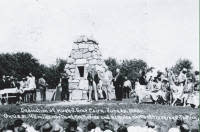
Thousands attended the dedication of the Hugh H. Gray Cairn on June 28, 1938. Constructed of 83 stones, one from each county in Michigan, the cairn features a bronze plaque bearing Gray’s likeness and proclaims him as the “Dean of Michigan’s Tourist Activity.” (Author’s Collection)
The dedication of the Hugh J. Gray Cairn was the climax of Gray’s first 21 years with the WMTRA, and his successful effort to build Michigan into the “Tourist Empire of the Inland Seas.” By the time the ceremony took place in 1938, tourism had grown into Michigan’s second largest industry, bringing in $315 million in 1937, outranking even California in the tourism industry. Gray didn’t know about the plans for the cairn until a formal announcement was made. He took pardonable pride in the fact that the suggestion for the monument came from the Southeastern Michigan Tourist Association, a group outside the West Michigan area that he served. A special testimonial banquet was held in Gray’s honor at the Park Place Hotel in Traverse City the night before the monument’s dedication. More than 200 men and women from all over Michigan attended. Lee Wilson Hutchins, the president of the WMTRA at the time, was the toastmaster. A dozen or so of Gray’s friends and business associates gave a series of short speeches. Arthur Stace, who had first suggested the idea of a state tourist association, introduced Gray, who modestly said:
“Michigan has everything for successful promotion as a summer playground, so the first credit must go to this great state for its position today. Then, in my work, I always had the loyal support of all my friends who had as great a faith in the future of Michigan as I had. Then, every state department gave us the full support in our efforts and one of the really great factors in developing Michigan is the splendid cooperation accorded us by the newspapers. It was all of these factors, working together, and not so much what I did, which has created this garden spot as the summer haven of the nation.”
Gray remained with the West Michigan Tourist and Resort Association for five more years, until his death in 1943. During his years in Grand Rapids, he traveled widely throughout Michigan and claimed that he had fished almost every stream and lake in the state. He was indeed the “dean of Michigan’s tourist activity,” and his legacy lives on in Michigan’s vibrant tourist industry of the 21st century.
Special thanks to Christine Byron for writing this wonderful article, and to her and the Grand River Valley History Magazine for allowing us to put the article online. Originally published in the Grand River Valley History Volume 23, 2008. Thanks to the Grand Rapids Historical Society c/o Grand Rapids Public Library.
About the author: M. Christine Byron is a librarian in the Grand Rapids and Special Collection Department of the Grand Rapids Public Library. With her husband, Thomas R. Wilson, she is the author of Vintage Views of Leelanau County and Vintage Views of the Charlevoix-Petoskey Region.
Win a Pass to Riverside Canoe Trips!
Check back the first of each month for a new West Michigan giveaway! Make sure you like our West Michigan Facebook Page for even more contests & freebies!
